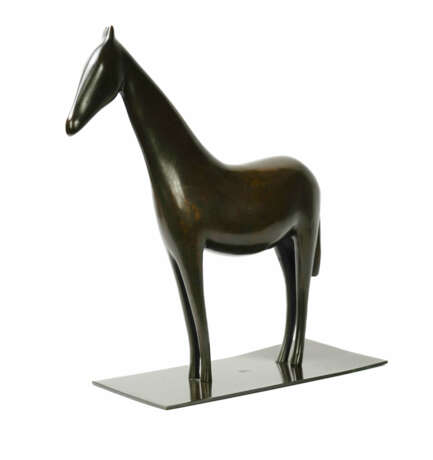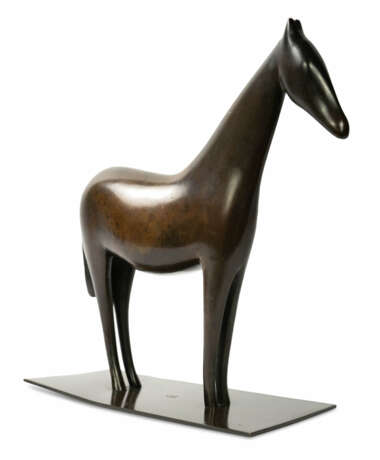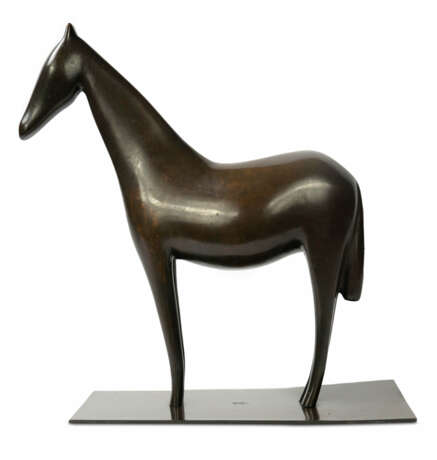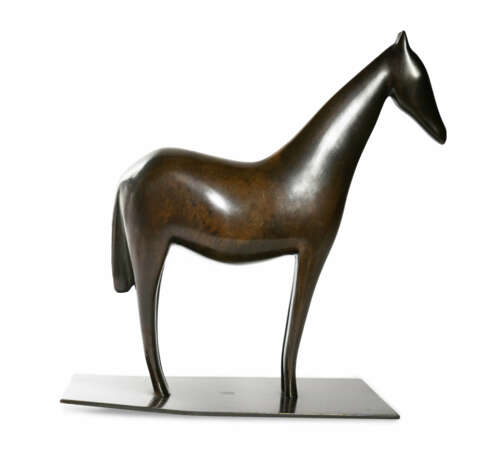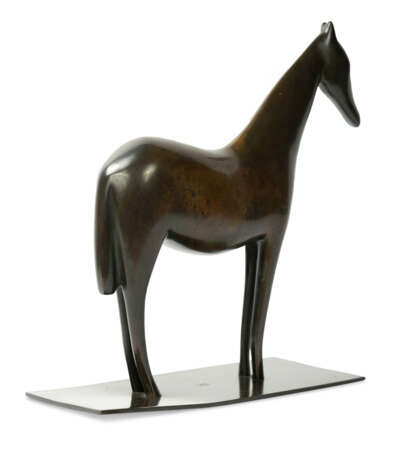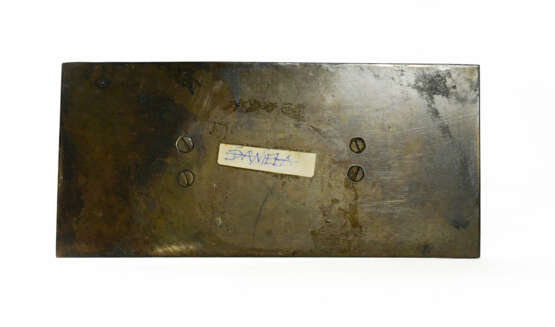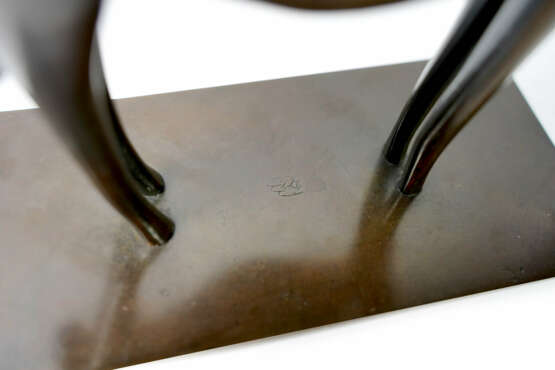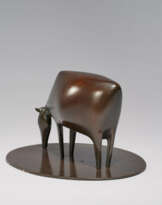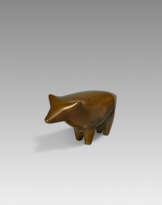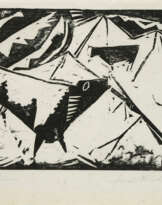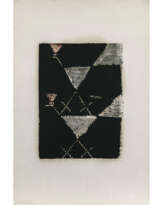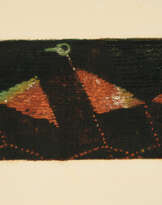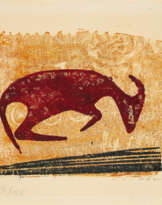ID 952162
Lot 40 | Ewald Mataré (1887 Aachen - 1965 Büderich) (F)
Estimate value
€ 39 000 – 60 000
'Finnisches Pferd', 1929/30, Bronze, braun patiniert, 26,5 cm x 22 cm x 10,5 cm, im Guss signiert, eines von insgesamt 14 Exemplaren, Plinthe verbogen, partiell leichte oberflächliche Kratzer, unterseitig Kleberückstände, Literatur: Wvz. Schilling 66b
Ewald Mataré war ein bedeutender deutscher Bildhauer und Grafiker, der zunächst zwischen 1907 - 1914 Malerei an der Kunstakademie in Berlin bei Lovis Corinth studierte und sich innerhalb der 1920er Jahre der Bildhauerei zuwandte. Holzschnitte und plastische Tierdarstellungen gehören zu den künstlerisch-handwerklichen Techniken, die Mataré besonders schätzte. Die Körper der Tiere reduzierte er auf flächige Grundformen und stellte sich der geistigen Herausforderung die Anatomie des Animalischen in eben diese Grundformen zu übersetzen. Als Material wurde vorwiegend Holz gewählt, dessen natürliche Maserung der Künstler durch glatte Oberflächenpolierung hervorzuheben wusste. An dieser Stelle muss darauf eingegangen werden, dass Mataré nicht von der Tätigkeitsbeschreibung des Schnitzens überzeugt ist - vielmehr sei es so, dass er als Künstler die Tiere aus einem plastischen Gedanken heraus bildhauerte. Der Künstler selbst beschreibt seine Arbeit an den Tierfiguren zu jenen Jahren als "fürstliches Vergnügen". Darauf geht er 1959 während eines Atelierbesuchs des Instituts für den wissenschaftlichen Film Göttingen näher ein. Mataré beschreibt eine glückliche Zeit, in der er einfach aus sich heraus, ohne jeden Zweck, ohne jede Notwendigkeit seine Tiere formte. Er erinnert sich selbst als alleinstehenden jungen Mann, der für sich selbst entscheiden konnte im Sommer in die Landschaften zu gehen, ans Meer, nach Spiekeroog, nach Sylt und nach Finnland. Sicherlich sind diese Tierdarstellungen angelehnt an die ältesten kunsthistorischen Tierdarstellungen, die es beispielsweise als Wandmalereien aus reinen Erdpigmenten in der Höhle von Lascaux (Frankreich) bis heute erhalten sind. Jahrtausende alte Relikte der Kunst, die das Tier als überlebenswichtiger Begleiter des Menschen, als Raubtier, als heiliges Tier und als Teil der Natur zeigen. Das finnische Pferd stammt aus den Jahren 1929/1930, als der Künstler mit einigen wenigen Edelhölzern nach Finnland reiste. Vor Ort entstand die Plastik aus Holz, die dann in einem Zwischenguß in Bronze gefasst wurde. Ewald Mataré arbeitete die weitere Abstrahierung heraus, bis einige Merkmale des Tieres nicht nur reduziert wurden, sondern gar verschwanden. Einzuordnen ist das finnische Pferd noch bevor die Werke Matarés während des Nationalsozialismus als entartet galten. Ebenso noch bevor sich der Künstler religiös dominierten Themen und städtischen Auftragsarbeiten zuwandte: In den Jahren 1948-1956 erstellt er für die Stadt Köln vier Domportale, den Taubenbrunnen am Westportal, die Gürzenichtüren, die Lochner-Säule, das Mosaik am Alter Markt und weitere Arbeiten. Einerseits ehrt ihn dieses Vertrauen in seine Kunst, um das Stadtbild zu beeinflussen. Doch weiß Mataré auch um die schöne Zeit, in der er selbstständig und aus seinem Inneren heraus seine Tiere formte.
Ewald Mataré (1887 Aachen - 1965 Büderich) (F)
'Finnisches Pferd', 1929/30, bronze, brown patinated, 26,5 cm x 22 cm x 10,5 cm, signed in the cast, one of 14 copies in total, plinth bent, partially slightly scratched, underneath adhesive residues, Literature: Cat. Rais. Schilling 66b
Ewald Mataré was an important German sculptor and graphic artist who initially studied painting at the Berlin Art Academy with Lovis Corinth between 1907 - 1914 and turned to sculpture within the 1920s. Woodcuts and sculptural representations of animals are among the artistic-craftsmanship techniques that Mataré particularly valued. He reduced the animals' bodies to dimensional basic forms and took up the intellectual challenge of translating the anatomy of the animal into precisely these basic forms. The material chosen was predominantly wood, the natural grain of which the artist was able to emphasise through smooth surface polishing. Here, it must be pointed out that Mataré is not convinced of the activity description of carving - rather, it is said that as an artist he sculpted the animals out of a plastic thought. The artist himself describes his work on the animal figures in those years as a ''princely pleasure''. He elaborates on this in 1959 during a studio visit of the Göttingen Institute for Scientific Film. Mataré describes a happy time in which he simply formed his animals out of himself, without any purpose, without any necessity. He remembers himself as a single young man, who could decide for himself to go out into the countryside in summer, to the sea, to Spiekeroog, to Sylt and to Finland. Certainly, these depictions of animals are leaned on the oldest art-historical depictions of animals, which are preserved to this day, for example, as wall paintings made of pure earth pigments in the cave of Lascaux (France). Thousands of years old relics of art, that show the animal as a companion of man that is essential for survival, as an animal of prey, as a sacred animal and as a part of nature. The Finnish horse dates from 1929/1930, when the artist travelled to Finland with a few precious woods. On site, the sculpture was made of wood, which was then set in bronze in an intermediate casting. Ewald Mataré worked out the further abstraction until some features of the animal were not only reduced but even disappeared. The Finnish horse can be classified even before Mataré's works were considered degenerate during National Socialism. Likewise, even before the artist turned to religiously dominated themes and urban commissions: In the years 1948-1956, he created four cathedral portals, the dove fountain at the west portal, the Gürzenich doors, the Lochner column, the mosaic at Alter Markt and other works for the city of Cologne. On the one hand, this confidence in his art to influence the cityscape honours him. But Mataré also knows about the beautiful time when he formed his animals independently and from within himself.
| Artist: | Ewald Wilhelm Mataré (1887 - 1965) |
|---|---|
| Auction house category: | Sculpture |
| Artist: | Ewald Wilhelm Mataré (1887 - 1965) |
|---|---|
| Auction house category: | Sculpture |
| Address of auction |
WETTMANN Luxusuhren Bredeneyer Straße 119-121 45133 Essen Germany | ||||||||||||||
|---|---|---|---|---|---|---|---|---|---|---|---|---|---|---|---|
| Preview |
| ||||||||||||||
| Phone | +4920185785190 | ||||||||||||||
| Fax | +49 (0)208 439 17 35 | ||||||||||||||
| Buyer Premium | 14,28% | ||||||||||||||
| Conditions of purchase | Conditions of purchase | ||||||||||||||
| Shipping |
Postal service Courier service pickup by yourself | ||||||||||||||
| Payment methods |
Wire Transfer | ||||||||||||||
| Business hours | Business hours
|
